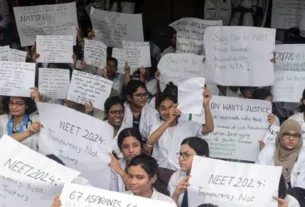MBBS vs AYUSH : The field of medicine in India encompasses various educational paths, two prominent ones being MBBS (Bachelor of Medicine, Bachelor of Surgery) and AYUSH (Ayurveda, Yoga & Naturopathy, Unani, Siddha, and Homoeopathy). Both systems have distinct curricula, training approaches, and scopes of practice, reflecting their unique historical developments and philosophical foundations.
MBBS is primarily grounded in allopathic medicine, which emphasizes the use of pharmaceuticals and surgical interventions to treat various diseases. The MBBS curriculum typically spans five and a half years, encompassing pre-clinical studies, clinical training, and internships. This comprehensive education aims to equip aspiring doctors with the necessary knowledge and skills to diagnose and manage a wide range of medical conditions effectively. Graduates are then eligible to practice as allopathic doctors, providing conventional medical treatments across various specialties.
In contrast, AYUSH incorporates a holistic approach to healthcare, integrating traditional practices with modern medicine. It comprises five distinct systems: Ayurveda, Yoga, Naturopathy, Unani, and Siddha, with foundations rooted in ancient Indian texts and philosophies. The AYUSH curriculum varies significantly among these modalities but generally focuses on natural remedies, lifestyle interventions, and preventive healthcare. AYUSH practitioners are trained to emphasize personalized treatment plans, balancing the body, mind, and spirit while considering the individual’s unique constitution and conditions. Education in AYUSH often extends for five and a half years, similar to MBBS, but with a focus on traditional medicine practices and methodologies.
Historically, MBBS has been linked to the Western medical model, gaining prominence during British colonial rule, while AYUSH has evolved from ancient Indian healthcare systems upheld through centuries. Today, both MBBS and AYUSH play vital roles in India’s healthcare landscape, addressing diverse health needs and preferences among the population. Understanding the differences between these two educational paths is essential in the ongoing discussions regarding their respective roles and recognition within the Indian medical framework.
Supreme Court Ruling: Context and Implications : MBBS vs AYUSH
The recent ruling by the Supreme Court of India has emphasized that there is no parity between MBBS and AYUSH degrees, a decision that has significant ramifications for the medical landscape in the country. This ruling emerged from a series of legal contests that spanned years, highlighting long-standing debates regarding the recognition and equivalence of traditional and modern medical practices. The court’s decision comes against a backdrop of societal perceptions that often conflate the training and expertise of AYUSH practitioners with that of allopathic doctors, creating confusion among patients and professionals alike.
In the lead-up to the ruling, various arguments were presented from both sides. Proponents of the AYUSH system argued for the recognition of their educational qualifications, asserting that practitioners of Ayurveda, Yoga, Unani, Siddha, and Homeopathy deserve equal status in the healthcare domain. They emphasized the growing acceptance of alternative medicine within society and pointed to the effectiveness of AYUSH treatments in certain scenarios. Conversely, MBBS advocates contended that the rigorous training and scientific basis underpinning allopathic medicine are essential for safe and effective patient care. They cautioned against the potential dangers of equating different medical systems that have fundamentally distinct philosophies and practices.
The implications of this ruling extend beyond the immediate impact on practitioners, as it reverberates through the medical education system and ultimately affects patient care in India. For MBBS professionals, this decision reinforces the exclusivity of allopathic training and may strengthen their professional standing. Conversely, AYUSH graduates might find their educational qualifications and practice rights limited, curbing their potential influence and participation in formal healthcare settings. The ruling also raises questions about the integration of various medical practices and how the healthcare system can accommodate both MBBS and AYUSH approaches without compromising standards of care and patient safety.
Reactions and Opinions : MBBS vs AYUSH
The Supreme Court’s declaration of no parity between MBBS and AYUSH has prompted a spectrum of reactions from diverse stakeholders, each reflecting their unique perspectives on this significant ruling. Medical professionals have largely expressed strong disapproval, emphasizing the necessity of maintaining rigorous standards in healthcare. Many practitioners argue that integrating AYUSH practices with modern medicine may lead to compromised patient safety and undermining of scientific evidence. Associations of allopathic physicians have voiced concerns about the implications this ruling may have on the quality of health services and the public’s trust in medical practices.
Conversely, AYUSH practitioners perceive this ruling as a setback to the recognition and validity of traditional medicine in India. They assert that their expertise, rooted in centuries of practice, offers valuable treatments that modern medicine often overlooks. Numerous AYUSH bodies have publically called for a review of the decision, voicing the need for better integration of different medical systems in a manner that respects each discipline’s unique contributions. This perspective underscores a growing movement advocating for parity in recognition and opportunities within the health sector.
Policy-makers have also weighed in, discussing the ruling’s potential implications on healthcare access, equity, and resource allocation. Some policymakers view the decision as a necessary step towards clearly defining the scopes of practice and educational standards across different medical fields. Others argue that it could hinder collaborative health initiatives aimed at providing comprehensive care that includes both modern and traditional practices.
Public opinion remains divided, with some advocating for a holistic approach to health care that encompasses all medical practices, while others support the supremacy of evidence-based medicine. Social media platforms have become a battleground for these debates, with various hashtags emerging to support one side or the other. Overall, the ruling reflects a complex landscape of beliefs regarding the intersection of traditional and modern medicine in India.
The Future of Medical Education in India
The recent Supreme Court ruling asserting that there is no parity between MBBS and AYUSH practitioners has profound implications for the future of medical education in India. As the landscape shifts, there is a pressing need for reforms in both streams to address the evolving healthcare needs of the populace. Ensuring that the educational frameworks for MBBS as well as AYUSH systems prioritize competency and patient safety is essential. This includes revising curriculum structures, upgrading training methods, and implementing rigorous assessment procedures that align with global medical standards.
One avenue for improvement involves enhancing the collaboration between different medical systems. While MBBS focuses primarily on allopathic practices, AYUSH encompasses a wide array of traditional practices that have garnered significant respect within Indian society. Bridging these areas can lead to a more holistic healthcare model that respects diverse medical traditions while segmenting the skill sets required for effective practice. This could be achieved through interdisciplinary training programs and workshops aimed at both MBBS and AYUSH practitioners, fostering mutual understanding and collaboration on patient care.
Additionally, promoting an integrated healthcare approach will be vital in addressing the demands of a diverse patient population. This initiative may include creating multidisciplinary health teams that combine the expertise of MBBS and AYUSH practitioners to offer comprehensive care. By leveraging the strengths of both systems, better health outcomes can be achieved while ensuring that patients have access to a variety of treatment options. Ultimately, reforming medical education in these ways will not only uphold standards of care but also enhance the efficacy and safety of healthcare delivery across India.





